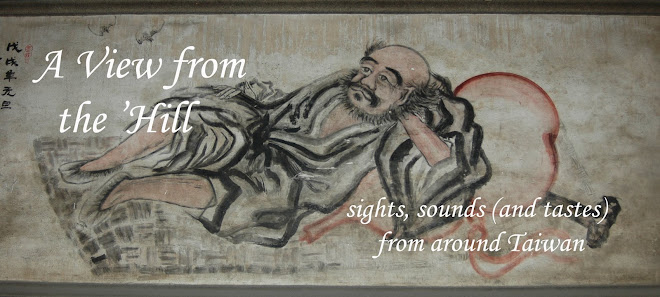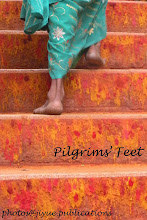Article in Amcham's TOPICS magazine:
Microbrewers Stake out a Market Niche
BY mark caltonhill
 [Photo: Author carrying out research at Taipei's Breeze Center]
[Photo: Author carrying out research at Taipei's Breeze Center]
Wen Li-guo likes beer. He likes beer so much that he decided to try to make some for himself, and so in 2002 he attended a course in home brewing organized by Duan Kwo-jen, professor of food science at Taipei’s Tatung University.
 Wen liked the beer he made, so he made some more. Wen’s friends liked the beer he made, so he made yet more. In fact, they liked it so much they suggested he give up his delivery job and start his own brewery. In June 2003 he followed their advice, and his North Taiwan Brewery (北台灣麥酒; Tel: 2299-7991) sold its first batch in August the following year. It now produces around 2,000 liters of fruit-flavored and Belgian-style beers every month.
Wen liked the beer he made, so he made some more. Wen’s friends liked the beer he made, so he made yet more. In fact, they liked it so much they suggested he give up his delivery job and start his own brewery. In June 2003 he followed their advice, and his North Taiwan Brewery (北台灣麥酒; Tel: 2299-7991) sold its first batch in August the following year. It now produces around 2,000 liters of fruit-flavored and Belgian-style beers every month.
But until eight years ago, what Wen does was illegal. Even his home-brewing hobby fell under a gray area of the law, since for the best part of 100 years, the manufacture and sale of alcohol in Taiwan had been a government monopoly, along with tobacco products and, originally, salt, camphor, and opium. This Monopoly Bureau was started during the Japanese colonial administration of the island (1895-1945), and then taken over by the incoming ROC government as a nice little earner that contributed as much as 8% of the total national budget revenue. Only with Taiwan’s entry into the World Trade Organization was the monopoly dismantled and licenses issued for private alcohol production. Several hundred of these licenses have been issued to date, but Wen estimates fewer than 100 have been for beer, and of these fewer than a dozen are currently making and marketing a product. And at least one, and not one of the smallest, has already gone bust.
Taiwan Beer, which as the monopoly bureau’s brand once commanded 100% of the market, still dominates with around 75%. It is followed by imported American, European, Japanese (mostly now brewed in China), and Chinese beers, which share almost another quarter, with Wen and his fellow microbrewers accounting for less than 1%. Clearly they are not called “micro” for nothing, though they generally prefer the term “craft beer,” claiming that their smaller quantities allow them to focus more on quality.
Aiming at the under-40s market, 41-year-old Wen and his two employees make lychee- and melon-flavored brews at 4% strength, a “White” wheat beer at 5%, and two “Abbey” beers at 6 and 8%. The fruit flavors are his biggest sellers, particularly popular among Taiwan’s growing population of female beer drinkers, so he is working to expand his range with apple and other flavors. He is also formulating a stronger beer, probably around 10%, having noticed a trend in male drinkers for beers with an extra kick.
“None of these will appear until I am certain about the stability of their quality,” Wen says. “For a small producer trying to establish myself in a niche market, quality is paramount. Also, it might entail significant investment as I would need larger premises.”
North Taiwan Brewery is currently located in Xinzhuang in Taipei County, just across the Danshui River from the city proper. “It is illegal to brew beer in Taipei or any other Taiwan metropolis,” he explains, “only in industrial zones.”
 [Photo: Le Ble D'or with distinctive swing-top cap from Jason's etc]
[Photo: Le Ble D'or with distinctive swing-top cap from Jason's etc]
Similarly, while the main outlets for fellow microbreweries Jolly, Deluxe (www.deluxebeer.com.tw), and Le Blé D’or (www.lebledor.com.tw) are located in Taipei City, their beers are brewed in Taipei County’s Zhonghe, Tucheng, and Sanchong respectively. Taiwan Tobacco and Liquor Corp., the corporate, post-WTO incarnation of the former Monopoly Bureau, has also had to relocate its beer production from the prime Jianguo factory in central Taipei to Linkou and elsewhere.
Wen had originally wanted to call his beer “Taipei Beer,” but this was rejected by the licensing authority on the grounds that the Jianguo brewery was also known as the Taipei brewery, he says. His next application, for “Northern Taiwan,” was accepted, however, and he feels this is almost as good, since Taipei (台北; “Taiwan north”) and his “Bei-tai” (北台) brand merely have their characters reversed.
 [Photo: LR Connie Guan of Guandu's 92 Shuiniao restaurant with her Shuiniao (Waterfowl) beer made by North Taiwan Brewery]
[Photo: LR Connie Guan of Guandu's 92 Shuiniao restaurant with her Shuiniao (Waterfowl) beer made by North Taiwan Brewery]
Around 70% of Wen’s outlets are in the Taipei area, he says. So far about 70 to 80 restaurants and shops are selling his bottled brews, either under his own brand names or their own, such as the Shuiniao Restaurant in Guandu that offers “Waterfowl” (水鳥) beer. Wen claims that these outlets contact him, and that he isn’t desperate to find more because that would mean expanding his operations and finding larger premises.
Nevertheless, with his beers gaining a growing following and with the apple-flavored brew almost ready for launch, Wen might not have much choice in the matter. Future plans also include a draft version of his beers for sale in bars, and with the shipment last month of the first export order to Singapore, overseas sales could be set to take off.
All in all, Wen gives the impression that he’s doing something he loves, but perhaps he’d still rather be making and drinking his homebrew than touting it in the fickle and faddish Taiwan marketplace.
 Eddie Chang, founder, owner, and master brewer of Jolly Brewery and Restaurant (卓莉手工釀啤酒+泰食餐廳; www.jollys.tw), also clearly loves what he’s doing. But that’s about all he has in common with Wen Li-guo. Chang comes from the other end of the Taiwan-microbrewers spectrum. Rather than a hobby brewer turned professional, he’s a graduate of restaurant management who spotted a vacant niche in Taiwan’s densely populated food-and-beverage market and so turned to brewing. “To tell the truth, I don’t really drink beer,” he says. “Two small glasses get me drunk.”
Eddie Chang, founder, owner, and master brewer of Jolly Brewery and Restaurant (卓莉手工釀啤酒+泰食餐廳; www.jollys.tw), also clearly loves what he’s doing. But that’s about all he has in common with Wen Li-guo. Chang comes from the other end of the Taiwan-microbrewers spectrum. Rather than a hobby brewer turned professional, he’s a graduate of restaurant management who spotted a vacant niche in Taiwan’s densely populated food-and-beverage market and so turned to brewing. “To tell the truth, I don’t really drink beer,” he says. “Two small glasses get me drunk.”
Nevertheless, as a student in southern California he became fascinated by the microbrewing scene, with bars making beers in their basements and competing with the big players through local marketing and distinctive flavors and styles. Under the wing of one of his professors, Chang started experimenting with home brewing.
 When he returned to Taiwan at the age of 31 in 1997, the monopoly was still in force, so he took a job with Thai Town restaurant. Chang knew that the alcohol monopoly would end one day, and probably sooner rather than later, so he continued his homebrew experiments courtesy of supplies sent by his Californian contacts. Finally, once the WTO negotiations were nearing a conclusion, Chang returned to the United States for an 18-month intensive qualification as a brewmaster at Siebel Institute of Technology.
When he returned to Taiwan at the age of 31 in 1997, the monopoly was still in force, so he took a job with Thai Town restaurant. Chang knew that the alcohol monopoly would end one day, and probably sooner rather than later, so he continued his homebrew experiments courtesy of supplies sent by his Californian contacts. Finally, once the WTO negotiations were nearing a conclusion, Chang returned to the United States for an 18-month intensive qualification as a brewmaster at Siebel Institute of Technology.
The monopoly formally ended in January 2002, and by September of that year Chang’s Jolly Restaurant in Neihu (內湖) sold its first commercial beer. He says he chose Neihu because rents were cheaper than in central Taipei, and he found a suitable location in the new Donghu Road area where apartments were being purchased by professionals in his 30-45 target age range – people with sufficient disposable incomes and perhaps some knowledge of and interest in specialty brews. In 2005 he opened a second branch, this time in the downtown district near the Nanjing-Fuxing MRT station. “Qingcheng is a very unusual street, right near the MRT, but blocked off at one end so there aren’t too many cars, and with broad pavements suitable for walking,” he says. “So it is busy but not too busy.”
Jolly started with three brews: a 4.6% weizen, 5% pilsner and 5% pale ale. A stout at 6% was added in 2004, and a Scotch ale at 7.2% in 2006. In addition, Chang offers a “special brew.” In 2008 this was a Vienna-style lager, but Chang says he wanted to promote local produce, so in 2009 he switched to “honey ale” at 5.7%, and in July 2010 it will again change to passion fruit.
Chang says he listens to his customers’ suggestions a great deal, not just in regard to the next special brew, but for the layout of his restaurants, contents of his menus, and especially for the taste and quality of his beers. “This is something a small brewer can do more easily than a big company,” he says. And, as a consequence, his beers have matured over the years.
“I’ve altered some of the ingredients slightly,” Chang continues. “For example, I started by using dried yeast but later switched to a culture. I’ve also made changes to some of the timings and temperatures. Originally the mash temperatures were the same for all the beers, but altering them up or down within a two-degree range has helped improve the flavors.”
 Jolly’s weizen beer has always been the customers’ favorite, accounting for around 25% of all sales. “It’s not too bitter, so it suits Taiwanese tastes,” Chang says. Second is the pilsner, perhaps because it is closest to the beers Taiwanese drinkers are most familiar with, or perhaps just reflecting the fact that pilsners are the world’s most popular beers. The stronger Scotch ale – Chang’s personal favorite for its malty, sweeter flavor – comes next, followed by the pale ale, with the stout and special brew bringing up the rear at about 7% of sales each. Still, Chang has no intention of dropping them from his beer list. “I want to offer customers as wide a choice as possible,” he says.
Jolly’s weizen beer has always been the customers’ favorite, accounting for around 25% of all sales. “It’s not too bitter, so it suits Taiwanese tastes,” Chang says. Second is the pilsner, perhaps because it is closest to the beers Taiwanese drinkers are most familiar with, or perhaps just reflecting the fact that pilsners are the world’s most popular beers. The stronger Scotch ale – Chang’s personal favorite for its malty, sweeter flavor – comes next, followed by the pale ale, with the stout and special brew bringing up the rear at about 7% of sales each. Still, Chang has no intention of dropping them from his beer list. “I want to offer customers as wide a choice as possible,” he says.
He brews a 1,000-liter batch of weizen every three weeks or so, and one of stout every couple of months. Last year he produced around 43,000 liters of beer for his two restaurants, though some is discarded so that only the freshest beers reach his customers.
“We don’t filter the beer or use high temperatures to kill the yeast, so it’s still present in the beer, adding to the flavor. This does mean the beer has a shorter shelf life than commercial brands, however, and needs to be stored at less than 5℃,” Chang says. This also explains his reluctance to move into bottled beer. “Yes, we could increase our profits by tapping into the huge take-out market, but at a risk to our quality and therefore a risk to our brand image.”
Nevertheless, he is looking at that possibility, but the most likely next move for Jolly will be opening another branch, perhaps in Taichung. Like most microbreweries, Chang would like to brew on the premises, not so much to save on transportation costs, but rather to put on a show for customers, and even to teach them something about home brewing.
Despite the Californian bars that were his early influence, Chang has designed his spaces with families in mind, making them well lit and using lighter colors for decoration. The name Jolly is meant to personify this atmosphere, and it is the attitude he tries to instill in his staff. Moreover, the bars do not dominate the restaurants; indeed, these are restaurants rather than pubs. He decided on Thai cuisine, partly because of his experience in that field but also because the spicy and sour flavors were similar enough to Chinese food but still exotic. Unfortunately for him, Taiwan has seen an explosion in Thai restaurants since Jolly opened in 2002, many of them selling cut-price cuisine. Nevertheless, Chang’s restaurants are always busy and he hasn’t considered switching menus.
“Thai food and beer makes a great combination,” he says. “And although I don’t drink much beer myself, I get a lot of pleasure watching customers enjoy their food and drink.”
So what is the future for Taiwan’s small microbrewing scene?
Not much, according to Michel Blanc, owner of The Tavern and Capone’s bars. He doesn’t sell them himself, although he says he would like to, and has long dreamed of having his own label on a locally produced microbrewed beer. But consistency remains a formidable challenge for the microbrewers, he says. “They cannot maintain a stable quality, and they won’t be able to while they produce such small quantities – and they won’t be able to produce large quantities because there simply isn’t the market for it.”
This is something of a catch-22 situation for the microbrewers. With their low capitalization, they cannot afford the promotional activities of the likes of Taiwan Beer or Heineken. But with only word-of-mouth, their growth is slow. Twenty-something Jenny Chiang is typical of Taiwan’s new generation of drinkers, opting for a sweeter, lower-alcohol, fruit-flavored beer when she goes out at the weekend. For her this means drinking an imported beer, however, as the only Taiwan beer she has ever heard of is Taiwan Beer.
Nevertheless, the microbrewers might be threatening to make a small dent in Taiwan Beer’s market, because the former monopoly brewer has recently launched a “craft beer” available at its Hualien Winery plant and selected outlets. On the other hand, one of the first new companies to start up after the WTO-led breaking of he monopoly, Taiwan Micro Brewing Company based in Kaohsiung, which made designer craft beers for restaurants and bars in Taiwan’s four largest cities, has already closed down. So recently did the Deluxe bar in Taipei Arena.
And what about Taiwan’s home brewers? Will one of them emerge as the next Wen or Chang? To judge from the lively discussions on internet forums, many foreign visitors to Taiwan, particularly those in the recently graduated English-teaching crowd, are keen to keep up their home-brewing hobby. But these threads mostly end in frustration, since ingredients such as malt and hops, as well as equipment, are not readily available in Taiwan. Even when they are obtained from abroad, the island’s tropical and subtropical climate is not conducive to most types of beer making. The best bet seems to be making ale, which ferments at around 18-24℃ compared with 10℃ for lagers, and doing it in the winter. The only good news is that the former gray legal area is now clearly articulated in black and white: Anyone can make batches of beer up to 100 liters, even in Taipei City. Happy experimentation.



















+LR.jpg)

 [Photo: Traditional farmhouses are common throughout
[Photo: Traditional farmhouses are common throughout  [photo]
[photo] 

 Fresh oysters straight from the shell adorn a
Fresh oysters straight from the shell adorn a 


















